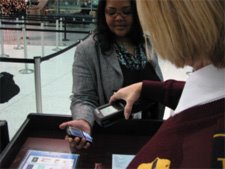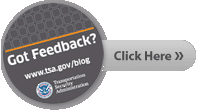
As many of us reflect on 9/11, I wanted to share the story about how I came to TSA and what it meant to wear the TSA uniform. In September 2001, I lived in Fairfield, Ohio and was living the rock and roll dream as a musician. My wife was working third shift. When I got out of bed on 9/11, my wife was still sound asleep.
I went through my normal morning routine, making coffee and reading the news on the internet. I pulled up CNN and read a developing story about a plane that had just hit the World Trade Center. The first thing I thought of was the
B-25 Bomber Plane that hit the Empire State Building in 1945. I was sure it had to be a similar type of accident.
I turned on the television and saw the World Trade Center tower on fire with giant plumes of smoke pouring out. Nobody quite knew what to make of it, but it was all too apparent what was going on after the second plane hit the south tower. America was under attack.
As I watched the news, my wife slept peacefully. I couldn’t bring myself to wake her. The world she knew when she went to bed that night would never be the same again.
It was hard for me to believe that I was feeling the same things as I had more than ten years earlier when the first Gulf War ground effort began. In 1991, I wore the uniform of a soldier of the United States Army while serving in the Persian Gulf with the 3rd Armored Division.
Thinking back, I remember wishing I was still in the Army so I could do something. In my college political science class, we talked about terrorism coming to America. I knew this was just the beginning and we’d get hit again eventually. So when I read about the formation of TSA, I was intrigued. I jumped at the chance to serve my country again. I proudly wore a new uniform, this time the one of at Transportation Security Officer, and serving again on the frontline to prevent another attack. Many other former military folks joined TSA along with me - today 25 percent of our frontline officers are veterans. Others also jumped at the chance to serve their country. I actually met people that took a pay cut to come work for TSA because the mission and the job meant that much.
The uniforms we wore weren’t the greatest, but we were proud to wear them. They identified us as frontline officers serving in the war against terrorism. Today, at airports around the country, passengers will see the new TSA uniform. I think the blue shirts look better, but most importantly, they better represent the dedication and professionalism of our officers. They also represent the evolution of our agency. The training, experience and nature of an officer's work today are far different than the job of a pre-9/11 "screener."
The uniform and badge are part of a series of changes at TSA, both cultural and operational. Soon, every person on the frontline, both officers and managers, will undergo two full days of revolutionary new training that will continue to change the focus from looking for bad things to looking for bad people. Security isn't better when officers follow a static checklist mentality - it's better when officers use their experience, judgment and training to assess the whole situation and look for the people with intent to do harm - people who might use common, everyday items like drinks or remote control toys converted into IEDs. That's why looking at behavior and other anomalies are so important.
Thinking back to 9/11 and when I joined TSA, I remember how people often said hello and even shook our hands. For the traveling public, it's been seven years without an attack in the U.S., and to many, the rules are now burdensome and our checkpoints are a necessary evil. For officers, it's one day at a time, with some days when you find a gun, a knife, hollowed out shoes, or items in bags that look like plastic explosives or an IED. Things that make the hair on the back of your neck stand up, your heart stop, because it's a threat until you can prove it's not one. It happens far more than you think, so when an officer asks to get a better look at you or your bag, know that it's because they want to make sure everything's okay.
Today, at airports around the country, officers on duty at 8:46 a.m. participated in a moment of silence to mark 9/11. The new uniform also carries a reminder of 9/11. If you look closely at the patch on an officer's left shoulder, you’ll see nine stars and eleven stripes behind the eagle. If you look at the eagle’s wing, you will see the Twin Towers. We think about it all the time so passengers can get safely to their destination. Our personal creed is “not on my watch.”
Bob
EoS Blog Team
Labels: mission








